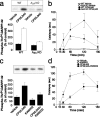Cannabinoid action depends on phosphorylation of dopamine- and cAMP-regulated phosphoprotein of 32 kDa at the protein kinase A site in striatal projection neurons
- PMID: 16162925
- PMCID: PMC6725667
- DOI: 10.1523/JNEUROSCI.1289-05.2005
Cannabinoid action depends on phosphorylation of dopamine- and cAMP-regulated phosphoprotein of 32 kDa at the protein kinase A site in striatal projection neurons
Abstract
Herbal cannabis, smoked in the form of marihuana or hashish, is the most common illicit drug consumed in the Western world. In the brain, cannabinoids interact with neuronal CB1 receptors, thereby producing a marked reduction of motor activity. Here, we report that the motor depressant effect produced by the cannabinoid receptor agonist (-)-cis-3-[2-hydroxy-4-(1,1-dimethylheptyl)phenyl]trans-4-(3-hydroxypropyl)cyclohexanol (CP55,940) is attenuated by genetic inactivation of the dopamine- and cAMP-regulated phosphoprotein of 32 kDa (DARPP-32), which is abundantly expressed in the medium spiny neurons of the striatum. Point mutation of Thr34, the protein kinase A (PKA) phosphorylation site of DARPP-32, produces a similar reduction in the effect of the CB1 agonist. In contrast, point mutation of Thr75, a site on DARPP-32 specifically phosphorylated by cyclin-dependent kinase 5, does not affect the behavioral response to CP55,940. Activation of CB1 receptors, either by an agonist or by inhibition of reuptake of endogenous cannabinoids, stimulates phosphorylation at Thr34, thereby converting DARPP-32 into an inhibitor of protein phosphatase-1. Genetic inactivation either of dopamine D2 receptors or of adenosine A2A receptors reduces the phosphorylation of DARPP-32 at Thr34 and the motor depression produced by CP55,940. Our data indicate that a considerable proportion of the psychomotor effect of cannabinoids can be accounted for by a signaling cascade in striatal projection neurons involving PKA-dependent phosphorylation of DARPP-32, achieved via modulation of dopamine D2 and adenosine A2A transmission.
Figures




References
-
- Baik J-H, Picetti R, Saiardi A, Thiriet G, Dierich A, Depaulis A, Le Meur M, Borrelli E (1995) Parkinsonian-like locomotor impairment in mice lacking dopamine D2 receptors. Nature 377: 424–428. - PubMed
-
- Beltramo M, Piomelli D (2000) Carrier-mediated transport and enzymatic hydrolysis of the endogenous cannabinoid, 2-arachidonylglycerol. NeuroReport 11: 1231–1235. - PubMed
-
- Bibb JA, Snyder GL, Nishi A, Yan Z, Meijer L, Fienberg AA, Tsai L-H, Kwon YT, Girault J-A, Czernik AJ, Huganir R, Hemmings HC, Nairn AC, Greengard P (1999) Phosphorylation of DARPP-32 by Cdk5 modulates dopamine signalling in neurons. Nature 402: 669–671. - PubMed
-
- Bidaut-Russell M, Devane WA, Howlett AC (1990) Cannabinoid receptors and regulation of cyclic AMP accumulation in the rat brain. J Neurochem 55: 21–26. - PubMed
Publication types
MeSH terms
Substances
Grants and funding
LinkOut - more resources
Full Text Sources
Molecular Biology Databases
